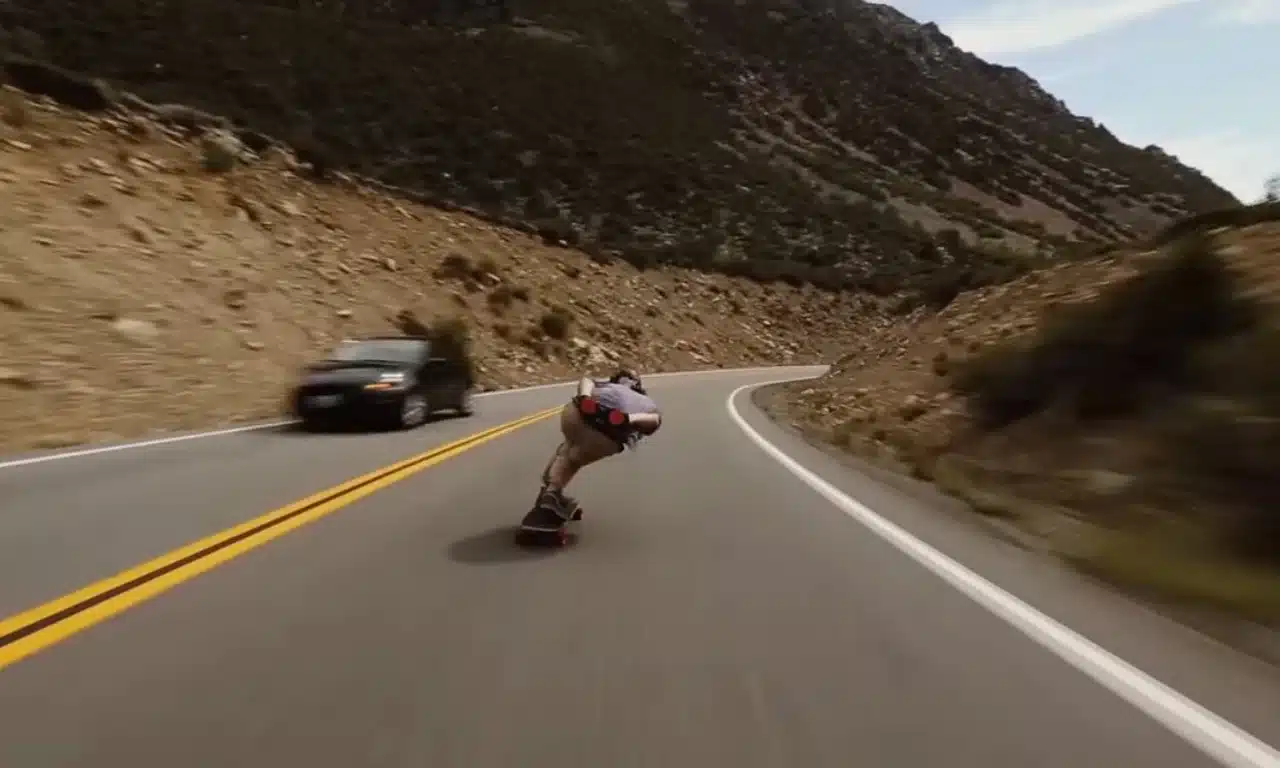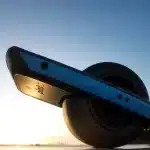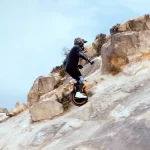
Speed wobbles or shimmy are an involuntary wobble of the steering of a vehicle at around 5-10 oscillations per second. The front of the vehicle oscillates left-right (yaw rotation) and if not countered can grow in amplitude until there may be loss of control (and a crash).
They can occur on any vehicle that has a single steering pivot, including bikes and motorcycles, scooters, trailers, skateboards, foils, electric unicycles, Onewheels and Floatwheels.
What causes speed wobbles
Speed wobbles can occur when the steering is underdamped (insufficient reduction or dissipation of an oscillation) and there is positive feedback (the correcting force in the steering is not reducing the fluctuations and may actually grow them). Some people describe them as resulting from a gyroscopic effect or resonance, although technically that’s not the principal cause.
It can often be difficult to predict and understand whether and when a particular vehicle will be susceptible to speed wobbles, as there are many variables involved, but there are often common traits to when speed wobbles occur:
- Bikes or motorcycles lacking suspension shocks (hence more an issue with road bikes rather than mountain bikes), less rigid bike frames (the older aluminium rather than modern rigid carbon frames), particularly while coasting downhill, or riding bikes with worn wheel bearings.
- Scooters with loose handle stems or a loose front wheel.
- Trailers that are loaded more toward the rear behind their axle.
- Skateboards when the rider weight is further back or higher up, or front trucks that are loose, or boards with a shorter wheelbase.
- Hydrofoils that have cheaper, less rigid masts.
- Electric unicycles or Onewheels when the rider is fatigued, tense or less experienced.
Speed wobbles often occur at a speed specific to the vehicle setup and the rider, particularly when traveling downhill, when braking hard, or when set off by a bump in a otherwise smooth road.
How to avoid speed wobbles
Although speed wobbles can occur in many types of vehicles and the mechanisms causing them can be complex there are commonalities in how to avoid them occurring, either by altering the vehicle or adjusting the rider stance/position:
- Having a correctly adjusted steering and rigid frame on a bike or scooter eg carbon bike frame, stiffer front forks or stem, tightened wheel bolts, maintained bearings, using a steering damper, riding with a more relaxed handle grip, and shifting rider weight forward.
- Buying an eFoil with a quality mast should give one that is extremely rigid and as the foil wing is under water (very heavily damped so unlikely to oscillate) any speed wobbles should be rare.
- Loading a trailer using the 60:40 rule (60% of the load distributed in front of the trailer axle and only 40% behind).
- Tightening skateboard trucks when intending to ride faster and using trucks with low pivot angles, keeping the rider’s centre of gravity lower down and further forward (60:40 rule), and for better skateboarders consider having a more longitudinal (forward) foot stance along the board centreline when at high speed (as used in downhill longboard racing).
- For skateboards, EUC and Onewheels/Floatwheels carving frequently to avoid an equilibrium state where oscillations might build up, riding more relaxed, taking breaks when legs are fatigued, riding slightly offset with more weight through the heel of the leading foot and front of the trailing foot to apply diagonal pressure on the board, or riding with either a slightly asymmetric stance or weight distribution on an EUC.
- For EUCs power pads provide more contact points for the rider and so help reduce speed wobbles, as can foot hooks or fins for Onewheels/Floatwheels.
Tyre pressure also plays a role, so checking correct tyre pressure is also important. Bikes are generally less likely to wobble if the tyre pressure is higher (steering is easier to correct), but on EUC’s and Onewheels lower pressure provides more ground contact so can help dampen fast oscillations (remembering that very low pressures increases the risk of tyre punctures and buckled rims).
What to do when speed wobbles do occur
Even experienced riders can experience speed wobbles, and especially so on skateboards, EUCs, and Onewheels/Floatwheels. Learning to manage them correctly is important for rider safety and for avoiding crashes, especially as speeds increase.
The two key rules are to always wear protective gear when riding at speed and not to panic when the wobbles do occur. Although speed wobbles can be disconcerting, panicking can make the rider more tense so further contribute to the positive feedback mechanism, and thus increase the amplitude of oscillations. Relaxing helps the body dampen the oscillating vibrations. Panic also leads to poorer decision making.
Because a speed wobble can only be sustained when the vehicle is in an equilibrium state, the key to stopping a speed wobble is to change something about the combined vehicle-rider system. Even a subtle change can quickly reduce or eliminate a wobble.
One way for novices to increase the dampening is to make contact with a higher-up part of the vehicle, such as placing one (or both) knee or shin against the top tube of the bike or the side of the EUC. This is a particularly easy way to reduce small wobbles before they increase, or when wobbles develop during a turn by leaning against the outside of the vehicle during the turn. Lightly breaking also helps (using the rear but not front brakes on two-wheeled bikes and scooters).
Shifting the rider weight further forward and/or lower is very effective. For the self-balancing EUC and Onewheels moving weight forward is not really an option but changing the distribution of foot pressure is straight-forward, such as placing more diagonal cross-foot pressure or shifting the rider weight to the outside edges of the feet.
For the bold (and more experienced) riders, accelerating also changes the dynamics (forward acceleration provides a stabilising effect), as does sitting down on an EUC (lowering the centre of gravity and giving more points of contact with the vehicle). If the rider’s legs are fatigued from standing then simply standing more upright (straighter legs) can help provide better and more precise foot control, even though this raises the centre of gravity.
For vehicles with handlebars generally relaxing the grip is advised to reduce the positive feedback, especially if the arms are shivering, as the relaxed arms and elbows can act to dampen the handlebar oscillations. For vehicles without handlebars, especially skateboards, EUCs and Onewheels performing carving, even hardly noticeable carving by slight changes in direction or shifts of weight, can reduce the oscillations. Carving also makes for a more enjoyable ride too so is a popular antidote to speed wobbles.


